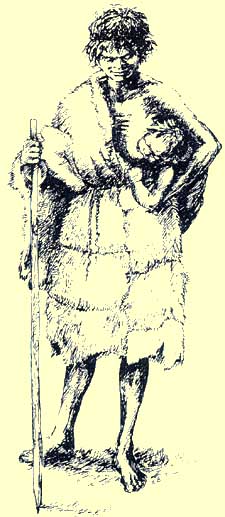
Political Awareness | In Parliament | The Workplace | Why South Australia?
The Aboriginal Voice | Cultural Diversity

 Continuing the motif of women in historical dress used
for the themes in this website, the illustration for The Aboriginal
voice is of a Kaurna woman in historical dress of possum skin,
carrying a Katta or digging stick. According to the South
Australian Museum, the woman is suckling her child according to
the customary method — the child is seated in a skin pouch at her
back, and reaches the breast by placing its head beneath the mother's
arm. This contemporary illustration by Adelaide artist Anne Best
is based on Woman and child of the Kaurna tribe by George
French Angas. It is reproduced here with her permission and the
permission of the Education Department of South Australia, from
The Kaurna people: Aboriginal people of the Adelaide plains.
Continuing the motif of women in historical dress used
for the themes in this website, the illustration for The Aboriginal
voice is of a Kaurna woman in historical dress of possum skin,
carrying a Katta or digging stick. According to the South
Australian Museum, the woman is suckling her child according to
the customary method — the child is seated in a skin pouch at her
back, and reaches the breast by placing its head beneath the mother's
arm. This contemporary illustration by Adelaide artist Anne Best
is based on Woman and child of the Kaurna tribe by George
French Angas. It is reproduced here with her permission and the
permission of the Education Department of South Australia, from
The Kaurna people: Aboriginal people of the Adelaide plains.
The Aboriginal voice is heard within the community as an agent for social, cultural, and political development. The Aboriginal voice also speaks for the land and for spiritual matters. This website gives a glimpse into the lives of several indigenous South Australian women who among other things have been successful political activists working within the broader political sphere, and together with the South Australian community and its institutions.
South Australian Dr Lowitja O'Donoghue, CBE, AM, is known and respected throughout Australia for her work with Aboriginal organisations and her role in the reconciliation process within the Australian community. Lowitja O'Donoghue delivered the 1998 Australian Library Week Oration at Tandanya Aboriginal Cultural Institute in Adelaide. This signifant address to a national forum addressed the importance of high quality library and information services to indigenous Australians.
Helen Jones' refers to the trailblazing role of Aboriginal women in the workplace in her book In her own name: a history of women in South Australia from 1836 revised edition (Adelaide, Wakefield Press, 1994) " Some Aboriginal women joined an occupational trend when they moved into a range of occupations including teaching, nursing and social work. This began tentatively in the 1950s and strengthened from the 1970s onwards. The early successes of these women in studying and achieving professional status have encouraged younger women to tread in their footsteps and increasingly to enter tertiary study. The age-old tradition of strong Aboriginal women within families and communities has been maintained by such women, by matriarchs like Mrs Olga Fudge, and by leaders such as Mrs Gladys Elphick and Mrs Maude Tongerie, foundation members of the Aboriginal Women's Council and the Aboriginal Medical Service". Another was Mary Williams. "Of great importance too was the 1985 graduation of Mrs Irene Watson LLB. She was the first Aboriginal woman to gain a law degree, which she used for the benefit of Aboriginal people."
During the Women's Suffrage Centenary year of celebrations, a writing project Aboriginal women reveal hopes and dreams for future generations resulted in the publication of a book Angiku compiled by Port Adelaide Girls High School students.
The State Library would be grateful for the opportunity to speak with indigenous Australians about material you might hold which documents your life and cultures and which you may be interested in donating to the Library or allowing to be copied for Library collections. You can contact the State Library's donations officer.
The Library endorses and has adopted the Aboriginal and Torres Strait Islander Protocols for Libraries, Archives and Information Services. In fact the State Library of South Australia was one of the key players in the working party drawing up the protocols, and hosted the first National Roundtable on Library and Archives Services to Aboriginal people in 1994. The national launch of the protocols was held at the State Library in Adelaide in 1995.
The Aboriginal people who lived on the Adelaide plains, where the State Library of South Australia stands, are the Kaurna people. A "Timeline of events affecting the Kaurna 1789-1989" is included in the publication The Kaurna people: Aboriginal people of the Adelaide plains. An Aboriginal studies course for secondary students in years 8-10 (Adelaide, Education Department of South Australia, 1989). As well, a select chronology of Aboriginal history in South Australia appears in Elizabeth Kwan's Living in South Australia: a social history (Netley, SA, South Australian Government Printer, 1987) in two volumes (volume 1 — From before 1836 to 1914, volume 2 — After 1914.) Another key resource is Survival in our own land: "Aboriginal" experiences in "South Australia" since 1836, told by Nungas and others ; edited and researched by Christobel Mattingley, co-edited by Ken Hampton, Rev. ed. (Sydney, Hodder & Stoughton, 1992).

| Copyright and this website | Disclaimer | Privacy | Feedback | Accessibility | FOI This page last updated on Monday 29 July 2019
|
State Library of South Australia |